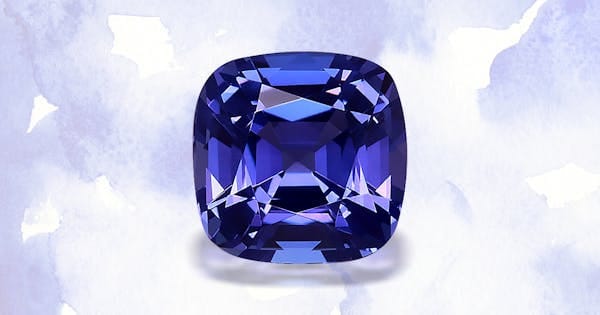
When Tiffany & Co. first laid eyes on a mineral specimen of zoisite with a blue color, they decided to call it ‘Tanzanite Gemstone’ because of its origins. They could have sold the stone under its mineralogical name, ‘blue zoisite’, but found that Tanzanite Stone would be easier to market and catch the interest of customers.
- Tanzanite Gemstone Color
- Pleochroism in Tanzanite
- Teaching the World about Tanzanite
- The Tanzanite Foundation
- Fine Tanzanite Gemstone Online
As the name suggests, the only known Tanzanite Gemstone source is in northern Tanzania. All the mines of the gem are located in an area around eight square miles big, situated in the Merelani Hills, near the base of Mount Kilimanjaro and the city of Arusha.
Most gemstones have been known and used for centuries; however, Tanzanite was discovered relatively recently, in the late 1960’s. In just over 60 years it has become the second most popular blue colored gemstone, second only to sapphire. There are only a small number of gemstones discovered within the last century that have brought a strong popularity amongst consumers, and Tanzanite is one of them. This popularity is due, mostly, because of its fantastic blue color, but also because of Tiffany & Co.’s excellent marketing. In fact, it is so popular that it was made the gemstone of December in 2002. It also matches Pantone’s color of the year for Most Popular Gemstone 2020.
1 TANZANITE GEMSTONE COLOR
Tanzanite Gemstone (Zoisite) occurs naturally in a range of colors, from colorless to brown, yellow and even pink, but it is the striking blues to bluish purple and bluish violet that make Tanzanite so appealing.
Transparent crystals of blue zoisite were discovered in the 1960’s and they created the interest it has today. Soon after, laboratories began experimenting with heating the stones and found that it could improve, and even change the color of some stones. Heating could turn naturally brown or green zoisite into blue stones. This discovery meant there was enough to support the demand.
Tanzanite’s blue color is caused by small amounts of vanadium inside its structure. When heated to 600 degrees Celsius for 30 minutes, the oxidation state of the vanadium changes, and causes the blue color to improve.
This heat treatment is mild in comparison to Sapphires or Rubies, which can be heated to temperatures between 1,000 and 1,800 degrees Celsius and kept at those temperatures for days. Most Tanzanite Stone on today’s market has been treated with hear in this way and has a significant effect on the value of the stone.
Untreated, naturally Blue Tanzanite is held with high regard in today’s market.
2 PLEOCHROISM IN TANZANITE
Pleochroism is a physical property in which the gemstone will appear to have different colors depending on the angle of the light. Tanzanite Stone is a pleochroic gemstone. Most are blue when viewed from one direction but can vary from violet to red when seeing from a different angle.
This physical characteristic can complicate the cutting process. The finished color of the gemstone will vary depending on how the table of the stone reflects the light in a rough state.
The most sought out color for Tanzanite is vivid blue. Cutters will have to examine each piece of rough and figure out what orientation to cut the stone, so it produces the best face-up blue color. If that is possible, they will then determine if changing the orientation can produce a larger, second-quality stone, which will fetch a higher price.
It takes great skill, knowledge and price estimation to accurately cut a Tanzanite gemstone. A cutter must examine the rough stone and determine which cut will fetch the best value. The stone is then cut into a preliminary shape, known as a preform. It must be done with extra care, as this step can either add or decrease the value of the stone.

Millionaire Miner 2020 : Finding the biggest Tanzanite
Tanzanian small-scale miner Saniniu Kuryan Laizer, 52, found two of the biggest of the country’s precious gemstones, Tanzanite.
Image Courtesy BangkokPost | Read More at BangkokPost.com
3 TEACHING THE WORLD ABOUT TANZANITE
When the first Tanzanite had been cut ready for market in 1967, the public knew nothing about the gem. Never before had they seen the color or heard the name. To introduce the world to the wonders of Tanzanite, Tiffany & Co. began an educational program for the public.
The jewelers prepared material that would make consumers aware of the gemstone and help other jewelers understand it and sell it. When a new gemstone is discovered, every person who sells and buys it must be educated before any deal can be completed.
In 2003, Tanzanite One Mining Ltd, the leading miner of the stone and a company who cuts, manufactures, wholesales and retails Tanzanite gems and jewelry, founded the Tanzanite Foundation. This is a non-profit organization promoting the marvelous gemstone, as well as educating the public about Tanzanite, in the form of training for retail staff in how to promote the gem.
Commercial-grade gemstones normally experience price instabilities. Tanzanite have great price comparisons between stones. High-quality, large stones are very rare and expensive. As a general rule, they also maintain their value in down markets and increase in price with rising markets.
4 THE TANZANITE FOUNDATION

The foundation aims to work in two key areas:
- Community Support: The Tanzanite Foundation carry the bulk of the community work Tanzanite One Mining invests in. They aim to fundraise and help support meaningful and sustainable projects, which are developed in harmony with the local and indigenous communities of Tanzania and its landscape.
- Tanzanite Education and Promotion: The Foundation is dedicated to educating consumers on behalf of the ethical and socially responsible operators within the Tanzanite industry. They ensure both businesses and induvial consumers are aware of the gemstone and all its attributes. Members and Endorsed Stockists of the Foundation are invited to request promotional packs and services, as well as help and support from the Foundation. These may include support with sales and marketing collateral, staff training and promotional help, amongst other things Tanzanite Gemstone related.
The principle of the Foundation is based on the belief that by increasing the demand and popularity of Tanzanite, they can sustain the industry’s economic viability and bring revenue and money to the source, for both Tanzanian communities and the country’s economy.

